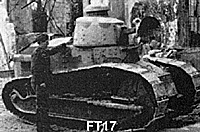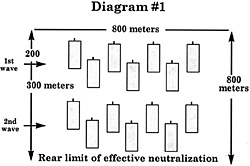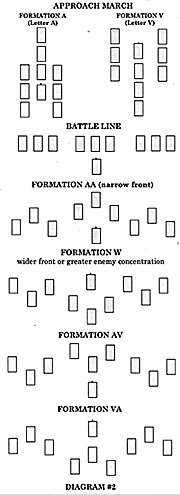French Tank Design
The French designed their tanks in order to fit their theories of the role of tanks in combat (See Chart I). Although most tanks were intended to perform both accompanying and supporting roles, there were often differences. Accompanying tanks were particularly designed to be well armored, to withstand small arms fire, artillery shell fragments, and light antitank fire. They had no need to move faster than the infantry they would accompany.
In fact, the French believed that speed added virtually no benefit to tanks in combat, since the faster tanks moved the more likely the crews were to miss sighting dangerous enemy weapons. This would leave both themselves and follow-on units exposed to danger. Supporting tanks, on the other hand, were generally lighter and faster. Cavalry tanks were lighter and faster still as they would find this necessary in the reconnaissance role.
Because of the distances they might need to move, cavalry tanks were more often fitted with radios. Accompanying tanks, on the other hand, were not viewed as needing radios. The latest tanks in the inventory, the breakthrough tanks, were fitted with radios.
The following types of tanks assigned to units during the Campaign were intended to fulfill the variety of roles expected of them:
 FT-17: The French recognized this World War I tank as obsolete, but like any country suddenly finding itself at war, they planned to use what they had. About half were equipped only with a machine gun. The remainder, however, operated a 37mm antitank gun, placing it above or on par in hitting value with most German tanks. They were not equipped with radios, and commanders used flags and hand signals to communicate with their units. The French had 534 of these tanks assigned to units at the beginning of the campaign, consisting of 15% of their starting total. In addition, there were more than 1,000 FT-17's available in reserve depots.
FT-17: The French recognized this World War I tank as obsolete, but like any country suddenly finding itself at war, they planned to use what they had. About half were equipped only with a machine gun. The remainder, however, operated a 37mm antitank gun, placing it above or on par in hitting value with most German tanks. They were not equipped with radios, and commanders used flags and hand signals to communicate with their units. The French had 534 of these tanks assigned to units at the beginning of the campaign, consisting of 15% of their starting total. In addition, there were more than 1,000 FT-17's available in reserve depots.
As befitted its slow speed, the FT-17 was intended as an accompanying tank. They were formed in platoons of five tanks each. Normal movement formation dictated a column with 20 meters between each tank. An FT-17 could move no faster than one to six kilometers per hour, and up to 20-25 kilometers per day.
In addition, they required a full day's rest and maintenance after two days of use. Battle formation was in a line with 50 meter intervals between tanks. An FT-17 tank platoon was expected to neutralize an area 200 meters in front and 400 meters deep. In combat, the FT-17 tanks and infantry were to move together in bounds of 300-600 meters.
AMC 33 and AMR 35: These were very light and fast moving tanks intended specifically for the reconnaissance role. They were assigned to light armored divisions (DLM), light cavalry divisions (DLC), and mechanized reconnaissance groups of infantry divisions.
FCM 36: This tank was a test model that only went into limited production. With its characteristics, it fell somewhere between an accompanying tank and a supporting tank. They equipped two tank battalions of 45 tanks each.
H-35 and H-39: 398 H-35's and 377 H-39's were on hand in units at the start of the Campaign. As faster moving tanks for cavalry operations, they were assigned to all types of French tank units. These tanks operated in companies of 20 tanks of five tanks per platoon.
R-35 and R-40: These tanks were assigned multiple roles, including accompanying, support, and cavalry. They were not equipped with radios, and so communication was through flags and hand signals.
The R-35 was by far the most numerous type of tank in the French inventory, comprising nearly one-third of the total armored force. They operated in 13-tank companies of four tanks per platoon and one commander's tank, and were assigned to the breakthrough divisions (DCR's).
D1: It is characteristic of the French that they would refer to this 20 kilometer per hour tank as a "fast" tank, though in combat it was still expected to move about eight kilometers per hour. The first French tank of the postwar period, the D1 was intended not for the accompanying role, but as forward support for neutralizing a zone in advance of an infantry attack.
 A company of 13 tanks, consisting of three tanks per platoon and a commander's tank, was expected to neutralize an area of 800 square meters (See Diagram 1 at right). The first wave of six tanks were trained to advance ahead of the second wave of six tanks 300 meters behind. The first wave, supported by artillery fire firing a rolling barrage, would neutralize enemy infantry and machine guns in an area 200 meters in front. The task of the second wave was to form a protective front for the leading wave against antitank guns and to mop up.
A company of 13 tanks, consisting of three tanks per platoon and a commander's tank, was expected to neutralize an area of 800 square meters (See Diagram 1 at right). The first wave of six tanks were trained to advance ahead of the second wave of six tanks 300 meters behind. The first wave, supported by artillery fire firing a rolling barrage, would neutralize enemy infantry and machine guns in an area 200 meters in front. The task of the second wave was to form a protective front for the leading wave against antitank guns and to mop up.
In their bounding movements, the tanks were to move no further than 1,500 to 2,000 meters forward in a single bound. Upon reaching their objective, they were to wait an estimated 20 minutes for infantry to catch up and establish their base of fire. This completed the first bound. The tanks and infantry would then repeat the process. As these tanks were equipped with radios, they could take on independent missions to attack artillery or other rear enemy positions, in which case they would not be restricted by bounding movements.
D2: As a forerunner of the Char B, the D2 was intended not only for the support role in infantry-tank operations, but also for providing a "shock" effect through its larger weight and armament. Only small numbers of these tanks were available, as they were superseded by the Char B. Organization and tactics for the D2 were the same as for the D1.
S-35: The S-35 was one of the best tanks in the French inventory. Among the German tanks only a flank or rear shot from a Pzkw III could hope to defeat it. The S-35 was intended to replace the lighter H-35 and H-39 series tanks in the cavalry role.
B1 and B1 bis: The heaviest main battle tank in the French Army, the "Char B" was more than an equal against any German tank. It was designed for "shock" value in the supporting role, in the counterattack, and in the breakthrough. Its heavy armor was virtually impervious to German tanks and standard antitank guns.
A Char B tank battalion had 50 officers and 610 men divided by a headquarters (Compagnie Hors Rang), three tank companies, and a service company (Compagnie d'Echelon). This included 33-35 tanks with ten tanks per company made up of three platoons of three tanks each. In addition, one tank was assigned to the battalion commander, a lieutenant colonel, one for the second-in-command, and one to three tanks were held as replacements.
 Doctrine for the Char B was for the tanks to move into battle in wedge formation, with three platoons of three in a V or inverted V, each also in that formation, with the company commander's tank either in the center either to the front or rear (See Diagram 2 at right). These modern tanks were radio operated, and, as noted in a US War Department report describing their use, "control by radio is particularly efficient."
Doctrine for the Char B was for the tanks to move into battle in wedge formation, with three platoons of three in a V or inverted V, each also in that formation, with the company commander's tank either in the center either to the front or rear (See Diagram 2 at right). These modern tanks were radio operated, and, as noted in a US War Department report describing their use, "control by radio is particularly efficient."
2C: This 60-ton monster was a relic of the Great War. With its 75mm howitzer, the 2C was intended for attacks on fortified positions and other special missions.
Unit Organization
The unit organization the French developed for their armed forces was designed around how they perceived the use of their armored forces. They were grouped into four basic units:
Independent Battalions and Companies
Half of France's armored force was comprised of 33 independent battalions and ten companies. The battalions typically held 63 FT-17's or 45 R-35's, and there were five independent Char B companies of 11 tanks each. These were to provide the primary tasks of accompanying and supporting infantry. As separate units, they would be assigned to infantry divisions as necessary.
DLM: Division Legere Mecanique (Light Mechanized Division)
The task of these divisions was to act as armored cavalry, providing a strong tank presence for an advance. A typical DLM comprised 160 tanks, usually 80 H-35 or H-39 tanks and 80 S-35 tanks, the former designated a reconnaissance brigade and the latter a combat brigade. The French had four of these divisions at the start of the campaign.
DLC - Division Legere de Cavalerie (Light Cavalry Division)
The DLC was intended for light reconnaissance and screening roles. Its job was to protect the flanks of an advance, to move well out in front and find the enemy, and to perform a holding action until more troops could move up. Once accomplished, it would pull back from the line. This type of unit was very light on tanks, usually with only 12 H-35 or H-39's and 20 AMR's among the tank components, though it also was equipped with 12 of the excellent Panhard P-178 armored cars with a 25mm main gun.
The chief advantage of the DLC was that it was a speedy and well-coordinated combined arms team, with two antitank companies, two artillery battalions, and a brigade of horsed cavalry. There were five DLC's in the French Army during the Campaign.
DCR - Division Cuirasse de Reserve (Heavy Armored Division of the Reserve)
Formed in response to the German successes with tanks against the Poles in 1939, these divisions were assigned the most powerful tanks in the French army, the Char B. These units, as newly defined, were intended to exploit a breakthrough on a front. Again, the combined arms team of infantry, artillery, and antitank guns were present to support the breakthrough. Most DCR's had about 70 Char B tanks and 90 H-39's. The French had three DCR's at the start of the Campaign, and hastily formed a fourth later on.
French Tank Tactics
-
Doctrine During the Inter-War Period
Tank Designs and Organization
Weaknesses in Armored Tactical Theory
Tactical Problems During the 1940 Campaign
Letter to Editor about Valverde
Back to Table of Contents -- Courier #72
To Courier List of Issues
To MagWeb Master Magazine List
© Copyright 1997 by The Courier Publishing Company.
This article appears in MagWeb (Magazine Web) on the Internet World Wide Web.
Other military history articles and gaming articles are available at http://www.magweb.com